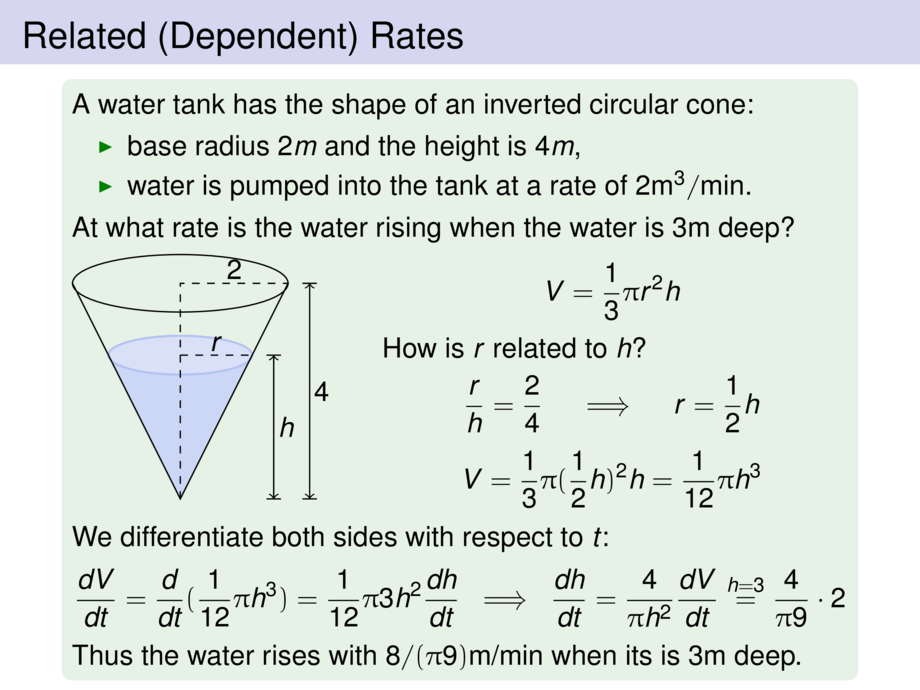



































































































45/87
\begin{frame}
\frametitle{Related (Dependent) Rates}
\vspace{-.5ex}
\begin{exampleblock}{}
A water tank has the shape of an inverted circular cone:
\begin{itemize}
\item base radius $2m$ and the height is $4m$,
\item water is pumped into the tank at a rate of $2\text{m}^3/\text{min}$.
\end{itemize}
At what rate is the water rising when the water is $3$m deep?
\begin{minipage}{.39\textwidth}
\begin{tikzpicture}[default,scale=1]
\draw [draw=none,fill=cblue!20] (0,0) -- (1,2) -- (-1,2) -- cycle;
\draw [draw=cblue!30,fill=cblue!15] (0,2) ellipse (1 and .27);
\begin{scope}[line width=.5pt]
\draw (1.5,3) -- (0,0) -- (-1.5,3);
\draw (0,3) ellipse (1.5 and .4);
\draw[<->] (1.3,0) -- node[right] {$h$} (1.3,2);
\draw[<->] (1.8,0) -- node[right] {$4$} (1.8,3);
\draw (1.2,0) -- (1.4,0);
\draw (1.2,2) -- (1.4,2);
\draw (1.7,0) -- (1.9,0);
\draw (1.7,3) -- (1.9,3);
\draw[dashed] (0,0) -- (0,3) -- node[above] {$2$} (1.5,3);
\draw[dashed] (0,2) -- node[above] {$r$} (1,2);
\end{scope}
\end{tikzpicture}
\end{minipage}
\begin{minipage}{.59\textwidth}
\pause
\begin{talign}
V = \frac{1}{3}\pi r^2 h
\end{talign}
\pause
How is $r$ related to $h$?
\pause
\begin{talign}
\frac{r}{h} = \frac{2}{4}
\mpause[1]{\quad\implies\quad r = \frac{1}{2}h}
\end{talign}\vspace{-2ex}
\pause\pause
\begin{talign}
V = \frac{1}{3}\pi (\frac{1}{2}h)^2 h \mpause[1]{= \frac{1}{12}\pi h^3}
\end{talign}
\end{minipage}
\pause\pause\medskip
We differentiate both sides with respect to $t$:
\begin{talign}
\frac{dV}{dt} = \frac{d}{dt} (\frac{1}{12}\pi h^3)
\mpause[1]{= \frac{1}{12}\pi 3h^2 \frac{dh}{dt} }
\mpause[2]{\;\implies\; \frac{dh}{dt} = \frac{4}{\pi h^2}\frac{dV}{dt} }
\mpause[3]{\stackrel{h=3}{=} \frac{4}{\pi 9} \cdot 2}
\end{talign}
\pause\pause\pause\pause
Thus the water rises with $8/(\pi 9)$m/min when its is $3$m deep.
\end{exampleblock}
\end{frame}

